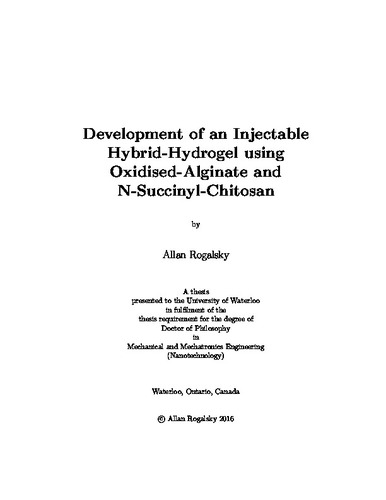| dc.contributor.author | Rogalsky, Allan | |
| dc.date.accessioned | 2016-01-18 20:06:26 (GMT) | |
| dc.date.available | 2016-05-18 04:50:09 (GMT) | |
| dc.date.issued | 2016-01-18 | |
| dc.date.submitted | 2016-01-14 | |
| dc.identifier.uri | http://hdl.handle.net/10012/10150 | |
| dc.description.abstract | A new oxidised-alginate / N-succinyl-chitosan hydrogel system with potential biomedical applications has been explored for precursor solution viscosities within the injectable range (<~0.2 Pa·s). When fully developed, its advantages may include: 1) good mechanical properties due to covalent crosslinking; 2) increased degrees-of-freedom to tailor properties and unique stress strain response due to the hybrid structure; 3) suitability for cell encapsulation / use as an injectable gel due to biocompatibility / mild formation conditions; and 4) excellent adoptability due to readily available and low cost raw ingredients.
The current work is focused on two initial studies of the system: 1) development of hybrid hydrogel compositions to meet target viscosity and stiffness ranges that are appropriate for common hydrogel applications, and 2) development and validation of models to predict hydrogel swelling and stiffness behaviour.
As gel systems become more complex, predictive tools are crucial for more focused development work so that end users can tailor gel systems to their precise requirements. In this work, we have undertaken the development and/or advancement of three predictive models: 1) advancing current swelling models to apply to hybrid systems containing polyampholytes; 2) refining membrane osmometry models to handle polyampholytes and to incorporate modern corrections for non-ideal solutions; and 3) proposing a new stiffness model for hybrid gel systems. These models were verified using a comprehensive experimental program for which new experimental equipment was custom-designed and built.
To form the new gels, limit-oxidized alginate (~45% repeat units modified) and six N-succinyl-chitosans (22 to 52% primary amine substitution) were synthesized from commercially available polymer. Solutions were prepared using phosphate buffered saline. A viscosity guideline of (<~0.2 Pa·s) was obtained from the injectability literature. This was easily met by oxidized-alginate solutions. N-succinyl-chitosan was limited to five substitutions (22 to 48%), with respective concentrations between 4.8 and 2.0 w/w%. Gels were formed by blending alginate and chitosan solutions at five different ratios (2:1 to 1:9). Gel stiffness was characterized in the 'as cast' state by compression testing. Swelling was characterized in phosphate buffered saline.
Our results showed that the stiffness model provided a good fit (largest p-value <0.03). From the model it was found that limit-oxidized-alginate is 16 times less stiff than N-succinyl-chitosan. This combined with the restricted injectable concentration range resulted in a maximum stiffness of 7 kPA, which is below the target window for muscle tissue (i.e. between 10 to 30 kPa). To simultaneously achieve both targets further investigation is recommended using higher concentrations of lower molecular weight chitosan or stiffer oxidized polysaccharides.
For N-succinyl-chitosan, the membrane osmometry model gave an excellent fit (largest p-value ~10⁻⁷). A key finding was that the Manning-Oosawa model for ion condensation does not accurately predict behaviour. The relatively fast rate of oxidized-alginate degradation prevented osmometry from being used to collect empirical ion condensation data. Without this data, classical swelling theory could not adequately predict experimental response. In future work, conductivity experiments are recommended to characterize ion condensation. Recent models by Trizac and O'Shaughnessy are recommended as improvements to the swelling theory.
The primary scientific contributions from this work are: 1) the first systematic characterization of the stiffness and swelling of injectable oxidised-alginate / N-succinyl-chitosan hydrogels; 2) the first analysis of polyampholyte ion condensation by membrane osmometry since the advent of modern ion activity models in the early 1990's; 3) the aforementioned advancement of osmometry and swelling theory; and 4) the proposal and successful experimental verification of a new model for hybrid gel stiffness.
In addition, a number of other contributions were also made, mainly: 1) a membrane osmometer was designed and built to characterize small samples of polyelectrolytes at elevated temperature and in concentrated chloride solutions, 2) N-succinylation was found to fit a log-linear empirical correlation with respect to input reagent concentrations; 3) a small increase in chitosan moisture affinity and thermal stability was observed with increasing N-succinyl substitution; 4) anomalous phase separation and rheological behaviour was observed in N-succinyl-chitosan solutions near the solubility limit; and 5) polyampholyte solution rheology was found to scale differently than that of polyelectrolytes.
Although the stiffness is below what was anticipated, the oxidised-alginate / N-succinyl-chitosan hydrogel system shows good potential. Provided the stiffness limitation can be overcome, the existence of high strain 'secondary stiffness' behaviour provides the potential for a much closer match to the non-linear elastic response of muscle tissue than is currently possible with single component systems. In addition, interesting phase behaviour near the N-succinyl-chitosan solubility limit may allow independent control of pore size and stiffness via a heterogeneous structure. | en |
| dc.language.iso | en | en |
| dc.publisher | University of Waterloo | en |
| dc.subject | oxidised-alginate | en |
| dc.subject | N-succinyl-chitosan | en |
| dc.subject | hybrid-gel | en |
| dc.subject | injectable-gel | en |
| dc.subject | membrane osmometry | en |
| dc.subject | swelling | en |
| dc.subject | stiffness | en |
| dc.title | Development of an Injectable Hybrid-Hydrogel Using Oxidized-Alginate and N-Succinyl-Chitosan | en |
| dc.type | Doctoral Thesis | en |
| dc.pending | false | |
| uws-etd.degree.department | Mechanical and Mechatronics Engineering | en |
| uws-etd.degree.discipline | Mechanical Engineering (Nanotechnology) | en |
| uws-etd.degree.grantor | University of Waterloo | en |
| uws-etd.degree | Doctor of Philosophy | en |
| uws-etd.embargo.terms | 4 months | en |
| uws.contributor.advisor | Sullivan, Pearl | |
| uws.contributor.advisor | Hyock Ju, Kwon | |
| uws.contributor.affiliation1 | Faculty of Engineering | en |
| uws.published.city | Waterloo | en |
| uws.published.country | Canada | en |
| uws.published.province | Ontario | en |
| uws.typeOfResource | Text | en |
| uws.peerReviewStatus | Unreviewed | en |
| uws.scholarLevel | Graduate | en |

